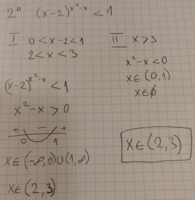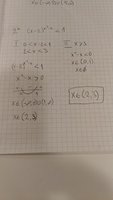You are using an out of date browser. It may not display this or other websites correctly.
You should upgrade or use an alternative browser.
You should upgrade or use an alternative browser.
question
- Thread starter trivun
- Start date
lev888
Elite Member
- Joined
- Jan 16, 2018
- Messages
- 2,939
Why do you think you are dealing with an exponential function?Hello everyone,
I believe this is a very silly question.
I've solved this one, but one thing bothers me. Solution includes 2, and I see 0 is smaller than 1 - but the definition for exponential function is for every a^x, a>0, in this case if x=2, a=0
Dr.Peterson
Elite Member
- Joined
- Nov 12, 2017
- Messages
- 16,090
I'm not sure what you mean by this. That's not a definition; I suppose you mean you have been told that a^x is called an exponential function only when a>0. But that doesn't mean that a^x is not defined unless a>0. Surely you learned long ago that 0^x = 0 for x non-zero, and that x^0 = 1 for x non-zero. Those facts don't change when you learn about exponential functions. And (as lev888 hinted) no one says you have to call this an exponential function.View attachment 24175
Hello everyone,
I believe this is a very silly question.
I've solved this one, but one thing bothers me. Solution includes 2, and I see 0 is smaller than 1 - but the definition for exponential function is for every a^x, a>0, in this case if x=2, a=0
The part I don't understand is why the inequality involves the factorial of 2 degrees. Can you explain that?
I thought that it was an exponential function because the inequation is not always true for x<2 (like exponential function, not defined for a<0, so i made a conclusion based on that) . Nevermind, I'm still in highschool so I do not undestand math absolutely clear only by only solving problems and not learning theory.
Thanks @Dr.Peterson , I I got it (as always when you explain).
Well, in my workbook there is the correct solution for every given problem. When I solved the problem, my solution was 2<x<3 and the solution in the book was 2<=x<3. Part that I did not understand is 2<=x.
Thanks @Dr.Peterson , I I got it (as always when you explain).
Well, in my workbook there is the correct solution for every given problem. When I solved the problem, my solution was 2<x<3 and the solution in the book was 2<=x<3. Part that I did not understand is 2<=x.
Dr.Peterson
Elite Member
- Joined
- Nov 12, 2017
- Messages
- 16,090
It will help if you show your work in finding the solution; then I can make more specific comments on steps, and where you could determine whether 2 is part of the solution set.I thought that it was an exponential function because the inequation is not always true for x<2 (like exponential function, not defined for a<0, so i made a conclusion based on that) . Nevermind, I'm still in highschool so I do not undestand math absolutely clear only by only solving problems and not learning theory.
Thanks @Dr.Peterson , I I got it (as always when you explain).
Well, in my workbook there is the correct solution for every given problem. When I solved the problem, my solution was 2<x<3 and the solution in the book was 2<=x<3. Part that I did not understand is 2<=x.
Dr.Peterson
Elite Member
- Joined
- Nov 12, 2017
- Messages
- 16,090
Maybe I should have reviwed the case when x=2 for this specific problem?

Yes, it looks like you based your work on some properties of exponentials that you have been taught, and they exclude the case where the base is zero, which is special. You just need to make that a case III. (I've seen problems like this, but with equality, where you also have to consider the case where the base is negative and the exponent is an integer, or a fraction with an odd denominator, or something like that. But I don't think that works here.)
Is \(2^\circ\) just the notation in your language for "2nd problem"?

